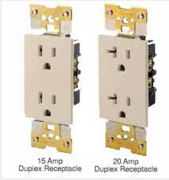Ever wondered what the numbers on electrical wire mean and why they matter? When tackling a home improvement project that involves electrical wiring, you’ll inevitably encounter terms like “12-2” and “14-2,” potentially leaving you scratching your head. Choosing the right wire is crucial for safety, ensuring your electrical system functions properly, and preventing potential hazards. This article will delve into the world of 12-2 and 14-2 wiring, helping you understand the differences, their proper applications, and why making the right choice is essential.

Image: pennaelectric.com
Understanding the difference between these wire types can seem complex at first glance, but it boils down to the wire’s gauge and the number of conductors. The gauge refers to the wire’s thickness, with smaller numbers indicating thicker wires. The number after the hyphen represents the number of conductors, including the ground wire. This article will unravel the mysteries of these seemingly simple numbers and equip you with the knowledge to make informed decisions about your electrical wiring.
Decoding the Numbers: 12-2 and 14-2
Gauge and Amperage
The gauge of a wire is directly related to its ability to carry electrical current. A thicker wire (lower gauge) can handle a higher amperage, meaning more electricity can flow through it safely. 12-gauge wire is thicker than 14-gauge wire, making it capable of handling more current. This is crucial for appliances and circuits with higher power demands.
Imagine electrical current as water flowing through a pipe. A thicker pipe (lower gauge wire) allows more water to flow through it than a narrower pipe (higher gauge wire). It’s similar with electrical wiring – a thicker wire reduces resistance, allowing more current to flow without overheating.
Conductors and Grounding
The number following the hyphen in “12-2” and “14-2” tells us the number of conductors in the wire. A “2” signifies that the wire has two insulated conductors (hot and neutral) and one bare copper ground wire.
The hot wire carries electricity from the power source to your appliances. The neutral wire carries the electricity back to the source after it has been used. The ground wire provides a path for electricity to safely flow to the ground in the event of a fault, protecting you from electric shock.
For clarity, let’s break down the commonly used 12-2 and 14-2 wires:
- 12-2: This wire is typically used for circuits that require a higher amperage, such as 20-amp circuits for appliances like refrigerators, air conditioners, or kitchen outlets.
- 14-2: This wire is typically used for circuits that require a lower amperage, such as 15-amp circuits for lighting and standard wall outlets in bedrooms or living rooms.

Image: www.espressooutlet.net
Navigating the Code: Choosing the Right Wire
The National Electrical Code (NEC) sets strict regulations for electrical wiring, including the minimum wire gauge required for specific circuits based on amperage. Here’s a simplified overview for common applications:
15-amp circuits: These circuits typically use 14-2 wire for outlets in areas like bedrooms, living rooms, and bathrooms. These outlets are designed for lower-power appliances like lamps, TVs, and small electronics.
20-amp circuits: These circuits often use 12-2 wire for outlets in areas like kitchens, laundry rooms, and garages. These outlets are ideal for high-power appliances like refrigerators, dishwashers, and microwaves.
It’s crucial to consult the NEC and local building codes for specific requirements. Using the wrong gauge wire can lead to safety hazards, including overheating, potential fires, or damage to your appliances.
Understanding the Risks of Using the Wrong Wire
Choosing the wrong wire type for a circuit can have serious consequences:
- Overheating: Insufficient wire gauge for the amperage of a circuit can lead to overheating, potentially causing fires or damaging appliances.
- Voltage Drop: A thin wire (high gauge) can cause a significant voltage drop, affecting the performance of appliances and potentially causing them to malfunction.
- Electrical Shock: If a thicker wire is used for a lower amperage circuit, it might not be properly protected by a circuit breaker. This could result in an electrical shock hazard.
Beyond the Basics: Factors to Consider for Wire Selection
While 12-2 and 14-2 are the most common wire types, other factors come into play when choosing the right wire for your project:
Amperage: As previously discussed, the amperage requirement of a circuit (determined by the appliances you’ll be connecting) determines the minimum wire gauge needed.
Circuit Length: Longer circuits can experience more voltage drop. For longer runs, especially with high-amperage circuits, the NEC might recommend using a larger gauge wire to compensate.
Environmental Conditions: Outdoor wiring might require a wire rated for specific temperature ranges and weather conditions. In harsh environments, using a wire with a higher temperature rating (e.g., THHN) might be necessary.
Application: Different types of electrical projects require specific wire types. For instance, wiring for lighting fixtures might use smaller gauge wire compared to wiring for large appliances.
12-2 Or 14-2 For Outlets
Conclusion
Understanding the difference between 12-2 and 14-2 wiring, along with other essential factors like amperage, circuit length, and environmental conditions, is crucial for safe and efficient electrical installations. Remember, always consult the NEC and local building codes for specific requirements and safety guidelines. If you’re unsure about choosing the right wire for your project, it’s always best to consult with a qualified electrician for guidance. By understanding these fundamentals and taking the necessary precautions, you can ensure that your electrical system functions reliably and safely.






